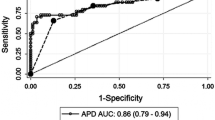Abstract
The sensitivity and positive predictive value (PPV) of fetal renal pelvic dilatation for detecting vesicoureteral reflux (VUR) can only be determined by performing voiding cystourethrography (VCUG) on all newborns in a study population. We sought to determine this for infants with a family history of reflux. From June 1989 to September 1996, 157 children (80 males) under 2 years with a family history of primary VUR in a first-degree relative had VCUG. VCUG results were compared with the fetal renal pelvic diameter on obstetric sonogram performed after 16 weeks gestation. Of the 157 infants, 33 (11 boys) had primary VUR. In those with a parent as the index case, the prevalence of reflux was 5% in boys and 35% in girls (P=0.03). The largest renal pelvic diameter after 16 weeks was not discriminatory for VUR, but after 30 weeks gestation a 4 mm renal pelvis had a sensitivity of 33% and a PPV of 32%. The sensitivity was higher for grades 4 and 5 (75%) than for grades 1–3 reflux (17%), (P=0.04). In conclusion, fetal renal pelvic diameter has a low sensitivity and poor predictive value for detecting VUR, but this improves a little after 30 weeks gestation.


Similar content being viewed by others
References
Marra G, Barbieri G, Moioli C, Assael BM, Grumiere G, Caccamo ML (1994) Mild fetal hydronephrosis indicating vesicoureteric reflux. Arch Dis Child 70:F147–F149
Scherz HC, Downs TM, Caesar R (1994) The selective use of dimercaptosuccinic acid in children with vesicoureteric reflux. J Urol 152:628–631
Van den Abbeele AD, Treves ST, Lebowitz RL, Bauer S, Davis RT, Retik A, Colodny A (1987) Vesicoureteral reflux in asymptomatic siblings of patients with known reflux: radionuclide cystography. Pediatrics 79:147–153
Anderson NG, Abbott GD, Mogridge N, Allan RB, Maling TM, Wells JE (1997) Vesicoureteral reflux in the newborn: relationship to fetal renal pelvic diameter. Pediatr Nephrol 11:610–616
Lebowitz RL, Olbing H, Parkkulainen KV, Smellie JM, Tamminen-Mobius TE (1985) International system of radiographic grading of vesico-ureteric reflux. Pediatr Radiol 15:105–109
Goldraich NP, Goldraich IH (1995) Update on dimercaptosuccinic acid renal scarring in children with urinary tract infection. Pediatr Nephrol 9:221–226
EPI-INFO (2002) Statistical Centers for Disease Control and Prevention, Atlanta, Georgia
Diem K, Lentner C (1970) In: Diem K, Lentner C (eds) Documenta Geigy Scientific Tables, 7th edn. Geigy, Basle
Scott JE, Swallow V, Coulthard MG, Lambert HJ, Lee RE (1997) Screening of newborn babies for familial ureteric reflux. Lancet 350:396–400
Aggarwal VK, Jones KV (1989) Vesicoureteric reflux: screening of first degree relatives. Arch Dis Child 64:1538–1541
Noe HN, Wyatt RJ, Peedon JN Jr, Rivas ML (1992) The transmission of vesicoureteral reflux from parent to child. J Urol 148:1869–1871
North RA, Taylor RS, Gunn TR (2000) Pregnancy outcome in women with reflux nephropathy and the inheritance of vesico-ureteric reflux. Aust NZ J Obstet Gynaecol 40:280–285
Wan J, Greenfield SP, Ng M, Zerin M, Ritchey ML, Bloom D (1996) Sibling reflux: a dual center retrospective study. J Urol 156:677–679
Noe HN (1992) The long term results of prospective sibling reflux screening. J Urol 148:1739–1742
Connolly LP, Treves ST, Connolly SA, Zurakowski D, Share JC, Bar-Sever Z, Mitchell KD, Bauer SB (1997) Vesicoureteral reflux in children: medicine and severity in siblings. J Urol 157:2287–2290
Chapman CJ, Bailey RR, Janus ED, Abbott GD, Lynn KL (1985) Vesicoureteric reflux: segregation analysis. Am J Med Genet 20:577–584
Sirota L, Hertz M, Laufer J, Jonas P, Boichis H (1986) Familial vesicoureteric reflux: a study of 16 families. Urol Radiol 8:22–24
Bonnin F, Lottmann H, Sauty L, Garel C, Archambaud F, Baudouin V, El Ghoneimi A, Loirat C, Bok BD, Aigrain Y (2001) Scintigraphic screening for renal damage in siblings of children with symptomatic primary vesico-ureteric reflux. BJU Int 87:463–466
Kenda RB, Kenig T, Budihna N (1991) Detecting vesico-ureteral reflux in asymptomatic siblings of children with reflux by direct radionuclide cystography. Eur J Pediatr 150:735–737
Connolly LP, Treves ST, Zurakowski D, Bauer SB (1996) Natural history of vesicoureteral reflux in siblings. J Urol 156:1805–1807
Coret A, Morag B, Katz M, Lotan D, Heyman Z, Hertz M (1994) The impact of fetal screening on indications for cystourethrography in infants. Pediatr Radiol 24:516–518
Crabbe DC, Thomas DF, Gordon AC, Irving HC, Arthur RJ, Smith SE (1992) Use of 99m technetium-dimercaptosuccinic acid to study patterns of renal damage associated with prenatally detected vesicoureteral reflux. J Urol 148:1229–1231
Buonomo C, Treves ST, Jones B, Summerville D, Bauer S, Retik A (1993) Silent renal damage in symptom-free siblings of children with VUR: assessment with technetium Tc99m dimercaptosuccinic acid scintigraphy. J Pediatr 122:721–723
Adra AM, Mejides AA, Dennaoui MS, Beydoun SN (1995) Fetal pyelectasis: is it always "physiologic"? Am J Obstet Gynecol 173:1263–1266
Anderson N, Clautice-Engle T, Allan R, Abbott G, Wells JE (1995) Detection of obstructive uropathy in the fetus: predictive value of sonographic measurements of renal pelvic diameter at various gestational ages. Am J Roentgenol 164:719–723
Acknowledgements
We are grateful to Lisa Borkus for help with data analysis and preparation of the manuscript. Sally Wright was funded by a summer studentship from the National Child Health Research Foundation.
Author information
Authors and Affiliations
Corresponding author
Rights and permissions
About this article
Cite this article
Anderson, N.G., Wright, S., Abbott, G.D. et al. Fetal renal pelvic dilatation—poor predictor of familial vesicoureteral reflux. Pediatr Nephrol 18, 902–905 (2003). https://doi.org/10.1007/s00467-003-1209-y
Received:
Revised:
Accepted:
Published:
Issue Date:
DOI: https://doi.org/10.1007/s00467-003-1209-y




